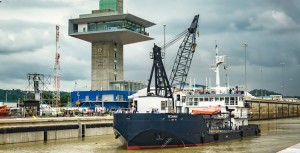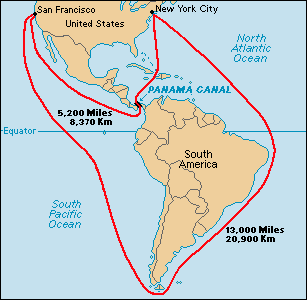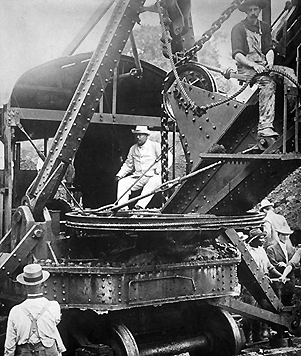Panama Canal Expansion
Wednesday, June 29th, 2016June 29, 2016
On Sunday, June 26, thousands of people lined the Panama Canal’s new Cocolí Locks as the colossal Chinese container ship Cosco Shipping Panama made the inaugural voyage through the canal’s new $5.25-billion expansion. The expansion, 10 years in the making and 2 years overdue, doubles the waterway’s previous shipping capacity. The new longer, wider, and deeper lock complexes allow the passage of most post-Panamax ships—gargantuan tankers and container and cruise ships that were once too large to fit through the canal (now described as neo-Panamax).

On June 20, 2016, the crane ship Oceanus runs a successful trial transit through the Cocolí Locks, part of the new Panama Canal expansion. The inauguration of the expanded Panama Canal took take place on June 26.
Credit: © Panama Canal Authority
With the expansion, the Panama Canal can now accommodate about 98 percent of all ships afloat. (The largest supertankers and aircraft carriers are still too big.) For neo-Panamax ships, the expansion significantly shortens the trip from China to the east coast of the United States—the canal’s most important commercial route. The expansion’s new lock chambers measure 1,400 feet (427 meters) long, 180 feet (55 meters) wide, and 60 feet (18.3 meters) deep. The older locks—still very much in use—measure 1,000 feet (304 meters) long, 110 feet (33.5 meters) wide, and 42 feet (12.8 meters) deep.
Construction on the expansion began in 2007 with the aim of opening on the canal’s 100th birthday in 2014. Various setbacks—including construction disputes, design flaws, funding and water shortages, leaky concrete, and work stoppages—delayed the expansion’s opening until Sunday. But Panamanian officials and citizens alike celebrated the better-late-than-never achievement, welcoming the increase in revenue and prestige brought by the expansion. The Panama Canal cuts across the Isthmus of Panama and links the Atlantic Ocean and the Pacific Ocean. It ranks as one of the greatest engineering achievements in the world.





